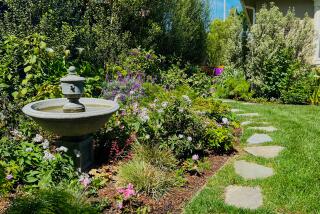John Givens recommends plump, vibrant green sugar snaps
GOLETA, Calif. — Five miles west along the coast from Santa Barbara, sugar snap pea plants grown by veteran organic farmer John Givens flourish on a south-facing, frost-free slope, climbing high up the stakes and strings arrayed to support them and bearing a bountiful crop of crisp, sweet, succulent pods — among the most beloved winter vegetables at local farmers markets, but they’re very particular as to growing area and season.
Different varieties of peas with rounded, edible pods have been around for hundreds of years but were mostly grown in small quantities in home gardens until 1979, when an Idaho breeder, Calvin Lamborn, introduced a more productive variety, Sugar Snap. However, it proved quite susceptible to powdery mildew, a fungal disease, and a vigorous, resistant variety, Super Sugar Snap, is now more widely grown, although it is not quite as sweet and succulent as the original. More than a dozen varieties are marketed as sugar snaps, including new purple cultivars.
Pea plants require cool weather to grow well, but the pods are destroyed by frost, so most of California’s crop is grown in coastal districts such as Arroyo Grande and Nipomo.
Givens sows seven 2-acre fields successively to harvest sugar snap peas from November to May, but the peak for quantity and quality is January through March.
Givens uses a tractor to plant sugar snap seeds, carefully covering them with dark shade cloth to keep meadowlarks from plucking and devouring them. After 10 days, his workers remove the shade cloth and put in stakes and strings for the plants to climb. In winter, sugar snap pea plants grow as tall as 8 feet, the harvest for a planting lasts about a month, and the pods abound; by May or June, the plants grow only 2 feet high, the harvest lasts just two weeks, and the pods are scanty. In the summer, Givens switches from growing peas to beans, which flourish in the heat.
Givens recommends choosing plump, well-filled, vibrant green pods, which are sweeter than flat, immature specimens. Avoid overmature pods with an overall whitish cast, which are tough and starchy; but green pods with a few white spots, caused by thrip damage, taste just fine. To eat, snap the pod near the stem and peel away the string from both seams. Good sugar snaps are perfect raw; they can also be steamed or stir-fried, but avoid overcooking.
Givens, 63, is a former hippie who has become a serious businessman. He studied industrial engineering at Cal Poly San Luis Obispo, then decided he didn’t like working indoors and apprenticed to a farmer in 1979. Soon he went out on his own to grow sugar snap peas, which brought good prices. He started selling at the Santa Barbara farmers market when it opened in 1983 and became certified organic in 1985. Although he struggled in the early years, his business instincts eventually made him one of the most successful farmers in his area.
“I try to pick crops that not too many other farmers are growing,” he says. “What you want are the crops that grow the fastest and fill the box the fastest.”
Sugar snaps don’t fill the box fast because their harvest is labor-intensive, but they fetch a high price, about $3.50 a pound wholesale and $5 a pound at farmers markets.
Givens now grows a wide range of vegetables at 10 locations on 170 acres. He sells a third of his harvest at 15 farmers markets, including Hollywood, Pacific Palisades, Studio City, Encino, Mar Vista, Burbank, Westlake Village, Calabasas, Larchmont and Ojai. In peak season he sends about 1,200 pounds of sugar snaps a week to farmers markets, where they usually sell out.
Other growers who sell high-quality sugar snap peas over the course of the season include Finley Farms, Richard Sager (Two Peas in a Pod), Shu and Debby Takikawa (The Garden of....., offering the original Sugar Snap variety), Coleman Family Farms, JR Organics, Marcie Jimenez and Fairview Gardens.
Seasonal tips: New-crop Delta asparagus from Zuckerman’s Farm, at Long Beach Sunday, Encino, Studio City, Hollywood and Santa Monica Wednesday; just one or two more weeks for supersweet, intensely flavored Sumo mandarins from George Farms, at Santa Monica Wednesday; juice-filled, highly aromatic passion fruit from JJ’s Lone Daughter Ranch, at Santa Monica Wednesday and Hollywood.
Despite last week’s storms, many farmers are facing the devastating prospect of losing much or all of their water because of the ongoing drought. To help provide tips and tools to conserve water, the Mar Vista farmers market will hold a Water Wise Expo on Sunday, March 16, from 9 a.m. to 2 p.m. Farmers who sell at the market will share how they have been affected by the drought, and experts will offer advice about removing water-wasting lawns, landscaping with water-saving native plants, and capturing and reusing water in the garden and home.
More to Read
Eat your way across L.A.
Get our weekly Tasting Notes newsletter for reviews, news and more.
You may occasionally receive promotional content from the Los Angeles Times.






